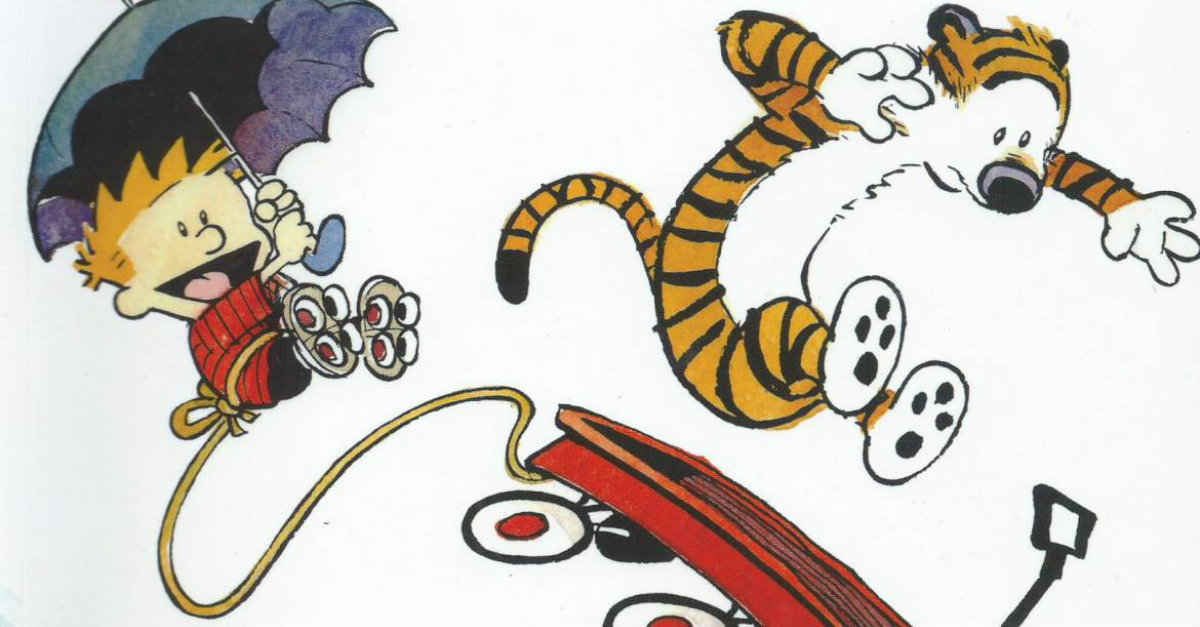As a child, I absolutely LOVED to read. English was hands-down my favorite subject, and I devoured my summer reading list the way other kids devoured popcorn. Books were a doorway to endless adventure and I honestly couldn’t get enough (I still can’t). Yet out of everything I read, the book I cherished above all others was my family’s battered copy of Calvin & Hobbes.
I’ve honestly lost count of how many nights I stayed up late laughing myself silly to Bill Watterson’s comic about a young boy and his stuffed tiger. Calvin & Hobbes had everything: time-traveling via cardboard box, daring escapes by Spaceman Spiff, and the kind of relatable mischief we’ve all experienced. What I didn’t realize at the time though was that Calvin & Hobbes wasn’t just entertaining, it was also helping me learn. The comic introduced me to new words, helped me process complex emotional lessons, and encouraged me to ask questions about things I didn’t understand. While it never appeared in my school syllabus, Calvin & Hobbes was still instrumental to my growth as a student.
The Case for Comic Books
Parents and educators have been debating the merits of comic books for years now. Maybe it’s the bright colors or the abundance of superheroes, but some critics still feel that graphic novels are closer to cheap television than classic literature. Regardless, many teachers have found that comic books provide reluctant readers with a useful outlet. Students who typically struggle with English suddenly become avid bookworms and develop new skills in language and communication. As it turns out, comics are helping to promote literacy in a surprising number of ways.
Some Literary Benefits
- Increased Interest in Reading: Students are more likely to read if a book appears fun and interesting. This offers comics a huge advantage. Unlike classroom literature, comics are marketed for enjoyment, so students won’t be as skeptical of them as, say, Bartleby, the Scrivener. Teachers can use comics to establish a literary foothold in their classroom, and even introduce larger works like The Odyssey and The Iliad.
- Improved Vocabulary: You can’t learn new words unless you encounter them. Like any piece of writing, comics have a wide vocabulary. Students can advance their language skills by discovering new words and deducing their meaning through context. You don’t need flashcards to teach vocabulary, you just need a few good panels.
- Recognizing Themes: All literature is built upon themes, and comic books are no exception. The graphic novel Maus exposes readers to the fear and cruelty of the Holocaust using themes of language, memory, and artistic style. Likewise, The Arrival conveys a message of solitude, alienation, and hope through silence and color schemes. Because comics are a mixed medium, they are often better equipped to teach students about complex ideas. Why not give them a try?
- Processing Social-Emotional Learning: As teachers, we want to help our students manage their emotions and deal with problems in a healthy manner. In this, comics have proven remarkably helpful. I Kill Giants, by Joe Kelly and J. M. Ken Niimura, depicts an eleven-year-old girl struggling to overcome her grief through escapism and then gradually acceptance. There’s also Nimona by Noelle Stevenson, which features a character’s search for identity while navigating feelings of anger. Sometimes all children need is a good story to help them find their way.
- Positive Representation: A teacher should never underestimate the power of positive representation. Our classrooms are filled with students form all backgrounds and seeing themselves as the hero (or seeing different people in that position) can go a long way to building their confidence, compassion, and understanding. Kamala Khan (aka Ms. Marvel) made huge strides as a Pakistani American superhero, while The Backstagers features a diverse group of misfits who exist outside the spotlight. Representation can mean the world to a student, so don’t miss this opportunity to help them grow!
Discover the Hidden Bookworm
We all know the old saying, “You should never judge a book by its cover.” That goes for comics too. A good story can come from anywhere. So, why not give your class a few graphic novels and watch as their imaginations soar? You may just inspire a lifelong love of reading!
Editor’s Note: Like all literature, some comics may not be suitable for all ages. Be sure to do your research before recommending a graphic novel to your students.
What about You? What are your thoughts on the comic debate? Share your experience in the comments below!
*Today’s Image is of Calvin and Hobbes by Bill Waterson. Get your copy today!

